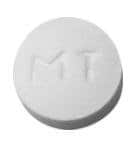Boxed Warning
QT prolongation:
Toremifene has been shown to prolong the QTc interval in a dose- and concentration-related manner. Prolongation of the QT interval can result in a type of ventricular tachycardia called torsades de pointes, which may result in syncope, seizure, and/or death. Toremifene should not be prescribed to patients with congenital/acquired QT prolongation, uncorrected hypokalemia, or uncorrected hypomagnesemia. Avoid drugs known to prolong the QT interval and strong CYP3A4 inhibitors.
Dosage Forms
Excipient information presented when available (limited, particularly for generics); consult specific product labeling.
Tablet, Oral:
Fareston: 60 mg
Generic: 60 mg
Pharmacology
Mechanism of Action
Nonsteroidal, triphenylethylene derivative with potent antiestrogenic properties (also has estrogenic effects). Competitively binds to estrogen receptors on tumors and inhibits the growth stimulating effects of estrogen.
Pharmacokinetics/Pharmacodynamics
Absorption
Well absorbed
Distribution
Vd: 580 L
Metabolism
Extensively hepatic, principally by CYP3A4 to N-demethyltoremifene (a weak antiestrogen)
Excretion
Primarily feces; urine (~10%) during a 1-week period
Time to Peak
Serum: ≤3 hours
Half-Life Elimination
Toremifene: ~5 days, ~7 days (females > 60 years); N-demethyltoremifene: 6 days
Protein Binding
Plasma: >99.5%, primarily to albumin
Use in Specific Populations
Special Populations: Hepatic Function Impairment
The mean elimination half-life was increased by less than 2-fold in patients with cirrhosis or fibrosis.
Special Populations: Elderly
Elimination half-life prolonged and Vd increased (457 vs 627 L) observed in elderly women.
Use: Labeled Indications
Breast cancer, metastatic: Treatment of metastatic breast cancer in postmenopausal women with estrogen receptor-positive or unknown tumors
Use: Off Label
Desmoid tumors (aggressive fibromatosis)c
Data from a retrospective review supports the use of toremifene for the treatment of desmoid tumors Fiore 2015. Data from a limited number of patients studied (case reports) also suggests that toremifene may be beneficial for the treatment of desmoid tumors Brooks 1992. Additional data may be necessary to further define the role of toremifene in this condition.
Contraindications
Known hypersensitivity to toremifene or any component of the formulation; congenital/acquired QT prolongation (long QT syndrome), uncorrected hypokalemia, uncorrected hypomagnesemia
Dosage and Administration
Dosing: Adult
Breast cancer, metastatic: Postmenopausal women: Oral: 60 mg once daily, continue until disease progression.
Desmoid tumors (aggressive fibromatosis) (off-label use): Oral: 180 mg once daily until disease progression or unacceptable toxicity (Fiore 2015). Additional data may be necessary to further define the role of toremifene in this condition.
Dosing: Geriatric
Refer to adult dosing.
Administration
Administer with or without food.
Dietary Considerations
Avoid grapefruit juice.
Storage
Store at 25°C (77°F); excursions permitted to 15°C to 30°C (59°F to 86°F); protect from heat. Protect from light.
Toremifene Images
Drug Interactions
Azithromycin (Systemic): May enhance the QTc-prolonging effect of Toremifene. Monitor therapy
Bosentan: May decrease the serum concentration of CYP3A4 Substrates (High risk with Inducers). Monitor therapy
Chloroquine: QT-prolonging Miscellaneous Agents (Moderate Risk) may enhance the QTc-prolonging effect of Chloroquine. Management: Monitor for QTc interval prolongation and ventricular arrhythmias when these agents are combined. Patients with additional risk factors for QTc prolongation may be at even higher risk. Monitor therapy
Clofazimine: QT-prolonging Miscellaneous Agents (Moderate Risk) may enhance the QTc-prolonging effect of Clofazimine. Management: Monitor for QTc interval prolongation and ventricular arrhythmias when these agents are combined. Patients with additional risk factors for QTc prolongation may be at even higher risk. Monitor therapy
CYP3A4 Inducers (Moderate): May decrease the serum concentration of CYP3A4 Substrates (High risk with Inducers). Monitor therapy
CYP3A4 Inducers (Strong): May decrease the serum concentration of Toremifene. Avoid combination
CYP3A4 Inhibitors (Strong): May increase the serum concentration of Toremifene. Management: Use of toremifene with strong CYP3A4 inhibitors should be avoided if possible. If coadministration is necessary, monitor for increased toremifene toxicities, including QTc interval prolongation. Exceptions are discussed in separate monograph. Exceptions: Ceritinib; Clarithromycin; Saquinavir; Voriconazole. Consider therapy modification
Dabrafenib: May decrease the serum concentration of CYP3A4 Substrates (High risk with Inducers). Management: Seek alternatives to the CYP3A4 substrate when possible. If concomitant therapy cannot be avoided, monitor clinical effects of the substrate closely (particularly therapeutic effects). Consider therapy modification
Deferasirox: May decrease the serum concentration of CYP3A4 Substrates (High risk with Inducers). Monitor therapy
Domperidone: QT-prolonging Agents (Moderate Risk) may enhance the QTc-prolonging effect of Domperidone. Management: Consider alternatives to this drug combination. If combined, monitor for QTc interval prolongation and ventricular arrhythmias. Patients with additional risk factors for QTc prolongation may be at even higher risk. Consider therapy modification
Erdafitinib: May decrease the serum concentration of CYP3A4 Substrates (High risk with Inducers). Monitor therapy
Fexinidazole [INT]: May enhance the QTc-prolonging effect of QT-prolonging Agents (Moderate Risk). Avoid combination
Gadobenate Dimeglumine: QT-prolonging Miscellaneous Agents (Moderate Risk) may enhance the QTc-prolonging effect of Gadobenate Dimeglumine. Management: Monitor for QTc interval prolongation and ventricular arrhythmias when these agents are combined. Patients with additional risk factors for QTc prolongation may be at even higher risk. Monitor therapy
Grapefruit Juice: May increase the serum concentration of Toremifene. Avoid combination
Halofantrine: QT-prolonging Miscellaneous Agents (Moderate Risk) may enhance the QTc-prolonging effect of Halofantrine. Management: Monitor for QTc interval prolongation and ventricular arrhythmias when these agents are combined. Patients with additional risk factors for QTc prolongation may be at even higher risk. Monitor therapy
Haloperidol: QT-prolonging Miscellaneous Agents (Moderate Risk) may enhance the QTc-prolonging effect of Haloperidol. Management: Monitor for QTc interval prolongation and ventricular arrhythmias when these agents are combined. Patients with additional risk factors for QTc prolongation may be at even higher risk. Monitor therapy
Inotuzumab Ozogamicin: QT-prolonging Miscellaneous Agents (Moderate Risk) may enhance the QTc-prolonging effect of Inotuzumab Ozogamicin. Management: Monitor for QTc interval prolongation and ventricular arrhythmias when these agents are combined. Patients with additional risk factors for QTc prolongation may be at even higher risk. Monitor therapy
Lofexidine: QT-prolonging Miscellaneous Agents (Moderate Risk) may enhance the QTc-prolonging effect of Lofexidine. Management: Monitor for QTc interval prolongation and ventricular arrhythmias when these agents are combined. Patients with additional risk factors for QTc prolongation may be at even higher risk. Monitor therapy
Lorlatinib: May decrease the serum concentration of CYP3A4 Substrates (High risk with Inducers). Management: Avoid concurrent use of lorlatinib with any CYP3A4 substrates for which a minimal decrease in serum concentrations of the CYP3A4 substrate could lead to therapeutic failure and serious clinical consequences. Consider therapy modification
Midostaurin: QT-prolonging Miscellaneous Agents (Moderate Risk) may enhance the QTc-prolonging effect of Midostaurin. Management: Monitor for QTc interval prolongation and ventricular arrhythmias when these agents are combined. Patients with additional risk factors for QTc prolongation may be at even higher risk. Monitor therapy
Ondansetron: QT-prolonging Miscellaneous Agents (Moderate Risk) may enhance the QTc-prolonging effect of Ondansetron. Management: Monitor for QTc interval prolongation and ventricular arrhythmias when these agents are combined. Patients with additional risk factors for QTc prolongation may be at even higher risk. Monitor therapy
Ospemifene: Selective Estrogen Receptor Modulators may enhance the adverse/toxic effect of Ospemifene. Ospemifene may also enhance adverse/toxic effects of other Selective Estrogen Receptor Modulators. Selective Estrogen Receptor Modulators may diminish the therapeutic effect of Ospemifene. Ospemifene may also diminish the therapeutic effects of other Selective Estrogen Receptor Modulators. Avoid combination
Pentamidine (Systemic): QT-prolonging Miscellaneous Agents (Moderate Risk) may enhance the QTc-prolonging effect of Pentamidine (Systemic). Management: Monitor for QTc interval prolongation and ventricular arrhythmias when these agents are combined. Patients with additional risk factors for QTc prolongation may be at even higher risk. Monitor therapy
Pimozide: May enhance the QTc-prolonging effect of QT-prolonging Agents (Moderate Risk). Avoid combination
Piperaquine: QT-prolonging Miscellaneous Agents (Moderate Risk) may enhance the QTc-prolonging effect of Piperaquine. Management: Monitor for QTc interval prolongation and ventricular arrhythmias when these agents are combined. Patients with additional risk factors for QTc prolongation may be at even higher risk. Monitor therapy
Probucol: QT-prolonging Miscellaneous Agents (Moderate Risk) may enhance the QTc-prolonging effect of Probucol. Management: Monitor for QTc interval prolongation and ventricular arrhythmias when these agents are combined. Patients with additional risk factors for QTc prolongation may be at even higher risk. Monitor therapy
QT-prolonging Antidepressants (Moderate Risk): May enhance the QTc-prolonging effect of QT-prolonging Miscellaneous Agents (Moderate Risk). Management: Monitor for QTc interval prolongation and ventricular arrhythmias when these agents are combined. Patients with additional risk factors for QTc prolongation may be at even higher risk. Monitor therapy
QT-prolonging Antipsychotics (Moderate Risk): QT-prolonging Miscellaneous Agents (Moderate Risk) may enhance the QTc-prolonging effect of QT-prolonging Antipsychotics (Moderate Risk). Management: Monitor for QTc interval prolongation and ventricular arrhythmias when these agents are combined. Patients with additional risk factors for QTc prolongation may be at even higher risk. Exceptions: Pimozide. Monitor therapy
QT-prolonging Class IC Antiarrhythmics (Moderate Risk): QT-prolonging Miscellaneous Agents (Moderate Risk) may enhance the QTc-prolonging effect of QT-prolonging Class IC Antiarrhythmics (Moderate Risk). Management: Monitor for QTc interval prolongation and ventricular arrhythmias when these agents are combined. Patients with additional risk factors for QTc prolongation may be at even higher risk. Monitor therapy
QT-prolonging Kinase Inhibitors (Moderate Risk): May enhance the QTc-prolonging effect of QT-prolonging Miscellaneous Agents (Moderate Risk). Management: Monitor for QTc interval prolongation and ventricular arrhythmias when these agents are combined. Patients with additional risk factors for QTc prolongation may be at even higher risk. Monitor therapy
QT-prolonging Moderate CYP3A4 Inhibitors (Moderate Risk): May enhance the QTc-prolonging effect of QT-prolonging Miscellaneous Agents (Moderate Risk). QT-prolonging Moderate CYP3A4 Inhibitors (Moderate Risk) may increase the serum concentration of QT-prolonging Miscellaneous Agents (Moderate Risk). Management: Monitor for QTc interval prolongation and ventricular arrhythmias when these agents are combined. Patients with additional risk factors for QTc prolongation may be at even higher risk. Monitor therapy
QT-prolonging Quinolone Antibiotics (Moderate Risk): QT-prolonging Miscellaneous Agents (Moderate Risk) may enhance the QTc-prolonging effect of QT-prolonging Quinolone Antibiotics (Moderate Risk). Management: Monitor for QTc interval prolongation and ventricular arrhythmias when these agents are combined. Patients with additional risk factors for QTc prolongation may be at even higher risk. Monitor therapy
QT-prolonging Strong CYP3A4 Inhibitors (Moderate Risk): Toremifene may enhance the QTc-prolonging effect of QT-prolonging Strong CYP3A4 Inhibitors (Moderate Risk). QT-prolonging Strong CYP3A4 Inhibitors (Moderate Risk) may increase the serum concentration of Toremifene. Management: Avoid concomitant use of toremifene and strong CYP3A4 inhibitors that prolong the QTc interval whenever possible. If combined, monitor patients for toremifene toxicities including QTc prolongation and TdP. Consider therapy modification
Sarilumab: May decrease the serum concentration of CYP3A4 Substrates (High risk with Inducers). Monitor therapy
Siltuximab: May decrease the serum concentration of CYP3A4 Substrates (High risk with Inducers). Monitor therapy
Sodium Stibogluconate: QT-prolonging Miscellaneous Agents (Moderate Risk) may enhance the QTc-prolonging effect of Sodium Stibogluconate. Management: Monitor for QTc interval prolongation and ventricular arrhythmias when these agents are combined. Patients with additional risk factors for QTc prolongation may be at even higher risk. Monitor therapy
Sugammadex: Toremifene may diminish the therapeutic effect of Sugammadex. Monitor therapy
Thiazide and Thiazide-Like Diuretics: May enhance the hypercalcemic effect of Toremifene. Monitor therapy
Tocilizumab: May decrease the serum concentration of CYP3A4 Substrates (High risk with Inducers). Monitor therapy
Vitamin K Antagonists (eg, warfarin): Toremifene may enhance the anticoagulant effect of Vitamin K Antagonists. Monitor therapy
Adverse Reactions
>10%:
Dermatologic: Diaphoresis (20%)
Endocrine & metabolic: Hot flash (35%)
Gastrointestinal: Nausea (14%)
Genitourinary: Vaginal discharge (13%)
Hepatic: Increased serum alkaline phosphatase (8% to 19%), increased serum AST (5% to 19%)
1% to 10%:
Cardiovascular: Edema (5%), cardiac arrhythmia (≤2%), cerebrovascular accident (≤2%), local thrombophlebitis (≤2%), pulmonary embolism (≤2%), thrombosis (≤2%), transient ischemic attacks (≤2%), cardiac failure (≤1%), myocardial infarction (≤1%)
Central nervous system: Dizziness (9%)
Endocrine & metabolic: Hypercalcemia (≤3%)
Gastrointestinal: Vomiting (4%)
Genitourinary: Vaginal hemorrhage (2%)
Hepatic: Increased serum bilirubin (1% to 2%)
Ophthalmic: Cataract (≤10%), xerophthalmia (≤9%), visual field defect (≤4%), corneal disease (≤2%), glaucoma (≤2%), visual disturbance (≤2%), diplopia (≤2%)
<1%, postmarketing, and/or case reports: Alopecia, angina pectoris, anorexia, arthritis, ataxia, blurred vision, constipation, corneal opacity (reversible; including corneal verticulata), depression, dermatitis, dyspnea, endometrial carcinoma, endometrial hyperplasia, fatigue, hepatotoxicity (including hepatitis, nonalcoholic fatty liver disease), jaundice, lethargy, leukopenia, paresis, polyp (uterine), prolonged Q-T interval on ECG, pruritus, rigors, skin discoloration, thrombocytopenia, toxic hepatitis, tremor, tumor flare, vertigo, weakness
Warnings/Precautions
Concerns related to adverse effects:
- Bone marrow suppression: Leukopenia and thrombocytopenia have been reported rarely; monitor leukocyte and platelet counts in patients with leukopenia and thrombocytopenia.
- Hepatotoxicity: Grades 3 and 4 transaminase increases and hyperbilirubinemia have been reported, including jaundice, hepatitis, and non-alcoholic fatty liver disease. Monitor liver function tests periodically.
- Hypercalcemia: May occur during the first weeks of treatment in breast cancer patients with bone metastases; monitor closely for hypercalcemia. Institute appropriate measures if hypercalcemia occurs; discontinue treatment if severe. Medications that decrease renal calcium excretion (eg, thiazide diuretics) may increase the risk of hypercalcemia in patients receiving toremifene.
- QT prolongation: [US Boxed Warning]: May prolong the QT interval; QTc prolongation is dose-dependent and concentration-dependent. QT prolongation may lead to a form of ventricular tachycardia called torsades de pointes, which may result in syncope, seizure and/or sudden death. Use is contraindicated in patients with congenital or acquired QT prolongation (long QT syndrome), uncorrected hypokalemia, or uncorrected hypomagnesemia. Avoid use with other medications known to prolong the QT interval and with strong CYP3A4 inhibitors. If concurrent use with QT prolonging agents cannot be avoided, interrupt treatment with toremifene. Use with caution in patients with heart failure, hepatic impairment, or electrolyte abnormalities. Monitor electrolytes; correct hypokalemia and hypomagnesemia prior to treatment. Obtain ECG at baseline and as clinically indicated in patients at risk for QT prolongation.
- Tumor flare: May occur during the first weeks of treatment in breast cancer patients with bone metastases. Tumor flare consists of diffuse musculoskeletal pain and erythema with initial increased size of tumor lesions (which later regress). It is often accompanied by hypercalcemia and does not imply treatment failure or represent tumor progression.
- Uterine malignancy: Endometrial cancer, hypertrophy, hyperplasia, and uterine polyps have been reported. Long-term use of toremifene in patients with pre-existing endometrial hyperplasia has not been established. Baseline and annual gynecological exams are recommended in all patients; closely monitor patients who are at high risk for endometrial cancer.
Disease-related concerns:
- Hepatic impairment: The half-life of toremifene is increased (less than 2-fold) in patients with hepatic impairment (cirrhosis and fibrosis), although the pharmacokinetics of N-demethyltoremifene (a metabolite with weak antitumor potency) were unchanged.
- Thromboembolic disease: Avoid use in patients with a history of thromboembolic disease.
Concurrent drug therapy issues:
- Drug interactions: Potentially significant interactions may exist, requiring dose or frequency adjustment, additional monitoring, and/or selection of alternative therapy. Consult drug interactions database for more detailed information.
Monitoring Parameters
CBC with differential (periodically), electrolytes (magnesium and potassium prior to and periodically during treatment; calcium periodically), hepatic function tests (periodically). Obtain ECG (baseline and periodically during treatment) in patients at risk for QT prolongation. In patients with bone metastases, monitor closely for hypercalcemia during the first few weeks of treatment. Baseline and annual gynecological exams (patients at high risk for endometrial cancer should be closely monitored). Signs/symptoms of uterine disorders (bleeding, discharge, pelvic pain/pressure).
Pregnancy
Pregnancy Risk Factor
D
Pregnancy Considerations
Based on the mechanism of action and data from animal reproduction studies, in utero exposure to toremifene may cause fetal harm.
Toremifene is only approved for use in postmenopausal women; however, if prescribed in premenopausal women, effective nonhormonal contraception should be used.
Patient Education
- Discuss specific use of drug and side effects with patient as it relates to treatment. (HCAHPS: During this hospital stay, were you given any medicine that you had not taken before? Before giving you any new medicine, how often did hospital staff tell you what the medicine was for? How often did hospital staff describe possible side effects in a way you could understand?)
- Patient may experience hot flashes, nausea, vomiting, lack of appetite, sweating a lot, or dry eyes. Have patient report immediately to prescriber signs of high calcium (weakness, confusion, fatigue, headache, nausea and vomiting, constipation, or bone pain), signs of liver problems (dark urine, fatigue, lack of appetite, nausea, abdominal pain, light-colored stools, vomiting, or yellow skin), fast heartbeat, abnormal heartbeat, severe dizziness, passing out, vision changes, chills, sore throat, muscle pain, seizures, pelvic pain or pressure, bruising, bleeding, vaginal discharge, or abnormal vaginal bleeding (HCAHPS).
- Educate patient about signs of a significant reaction (eg, wheezing; chest tightness; fever; itching; bad cough; blue skin color; seizures; or swelling of face, lips, tongue, or throat). Note: This is not a comprehensive list of all side effects. Patient should consult prescriber for additional questions.
Intended Use and Disclaimer: Should not be printed and given to patients. This information is intended to serve as a concise initial reference for health care professionals to use when discussing medications with a patient. You must ultimately rely on your own discretion, experience and judgment in diagnosing, treating, and advising patients.





